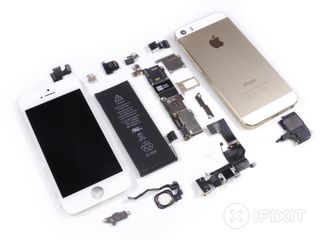iPhone 5S Teardown Reveals Glued Battery, Lack of M7 Chip
Here's what's inside the iPhone 5S.
Today is the first day of iPhone 5S and 5C availability but, depending on the color you wanted, you may not have been able to snag one at launch. If that's the case, you might want to avert your eyes, because the iFixit team did get one, and you know exactly what those people do when they get new toys.

Yes, even the iPhone 5S is not safe when it comes to iFixit's wandering tools. The phone was unceremoniously torn down last night, before most people even had a chance to buy it (the iFixit team sent someone to Australia to nab a unit). iFixit found a couple of interesting things when they dove inside the iPhone 5S. For one, the battery is now glued in place, which makes it even harder to replace yourself. For another, there wasn't actually a physical M7 co-processor. If you followed the launch event, you might remember Apple taking about the M7, which is in charge of motion data, measuring accelerometer, gyroscope and compass data continuously (Apple is eying health and fitness apps with this). However, according to iFixit, the chip doesn't exist.
"Also of note was the striking lack of a discrete M7 co-processor. Perhaps the "M" stands for "magical," because it’s not there, folks," the iFixit crew wrote. "The mythical M7 is most likely a combination of motion-oriented components, and not an actual dedicated chip (as Apple implied during last week’s product announcement). Chock it up to savvy marketing."
They also found the A7 chip (with 1 GB of RAM), a Qualcomm MDM9615M LTE Modem and WTR1605L transceiver, Hynic H2JTDG8UD3MBR NAND Flash, a Broadcom BCM5976 touchscreen controller, the same display as the iPhone 5, and an 8 MP iSight camera (with larger 1.5µ pixels) and a 1.2MP FaceTime lens up front.
Of course, one of the most interesting parts of this phone is the fingerprint sensor. Thanks to iFixit, we now know that Apple's Touch ID is basically a group of small capacitors that creates an image of the ridges on your finger. The technology was developed by AuthenTec. iFixit's concern is that the sapphire crystal covering the sensor won't protect the CMOS fingerprint sensor from degrading over time. Then again, it only really has to last a year, right?
Check out all the gory photos and the full teardown here.
Stay On the Cutting Edge: Get the Tom's Hardware Newsletter
Get Tom's Hardware's best news and in-depth reviews, straight to your inbox.
Follow Jane McEntegart @JaneMcEntegart. Follow us @tomshardware, on Facebook and on Google+.
-
Scott Evers Don't wipe the S too hard, these are just iphone 5's with an S drawn on with a sharpie.Reply -
Sorky iPhones are just overpriced junk. I've owned two iPhones in the past and both times the battery ended up dying. I had to hire someone to take it apart and replace the battery. I've junked both and switched to Samsung Galaxy phones. Now, I can pop off the back, replace the battery, replace the back cover, and I'm good to go. Apple sucks!Reply -
warezme Anyone else already sick and tired of iphone 5s articles? I went to gizmodo and it was like the ENTIRE site was bought and paid for by Apple, so sad.Reply -
WyomingKnott Reply11571018 said:Don't wipe the S too hard, these are just iphone 5's with an S drawn on with a sharpie.
I'll wipe my S as hard as I want to. -
JPNpower Gosh please stop with the apple hate. I get that you don't like it so keep the comments about the hardware OK?Reply -
edogawa One good thing about Apple news articles is that the comments generally tend to unite in agreement that Apple can go blow itself.Reply
-
stevejnb Reply11571141 said:Anyone else already sick and tired of iphone 5s articles? I went to gizmodo and it was like the ENTIRE site was bought and paid for by Apple, so sad.
Meh, while I am in NO way a proponent of Apple products beyond the people who I feel they are best suited for - such as my Nana, who I set up with an iPad rather than an Android tablet when she wanted to "start using the computer and doing the e-mail" - the reality is, Apple is one of the largest players in the technology world at the moment, and they tend to release product announcements only a few times a year and all at just a few events. It stands to reason that, when those events happen, there would be a glut of media attention - even pointless fluff articles like NBC is spamming out at the moment.
Conversely, we get a smaller but far more steady stream of Google, MS, etc information in general. We might actually get more of that, just far less concentrated so it seems like less. -
mensajd This appears to be the first commercial release of an ARMv8 64-bit processor. Is that not interesting news?Reply -
kawininjazx Hmm...do I get the iPhone 5s now, or do I wait for the iPhone 6, 6s, 6c, 7, 7s, 7pos?Reply
Most Popular



